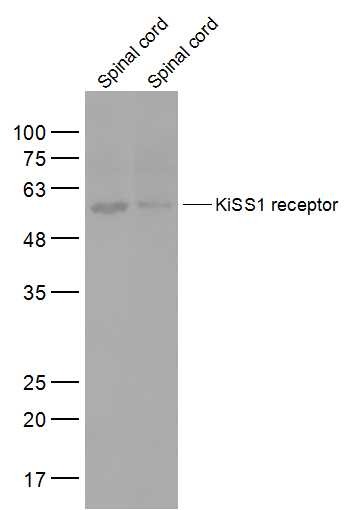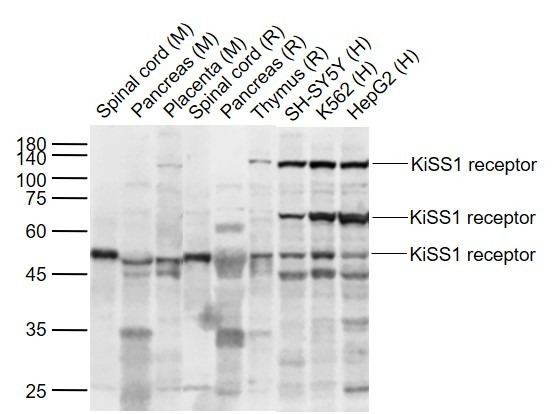Shopping Cart
Remove All Your shopping cart is currently empty
Your shopping cart is currently empty
Anti-KISS1 receptor Polyclonal Antibody is a Rabbit antibody targeting KISS1 receptor. Anti-KISS1 receptor Polyclonal Antibody can be used in WB.
| Pack Size | Price | USA Warehouse | Global Warehouse | Quantity |
|---|---|---|---|---|
| 50 μL | $220 | 7-10 days | 7-10 days | |
| 100 μL | $373 | 7-10 days | 7-10 days | |
| 200 μL | $528 | 7-10 days | 7-10 days |
| Description | Anti-KISS1 receptor Polyclonal Antibody is a Rabbit antibody targeting KISS1 receptor. Anti-KISS1 receptor Polyclonal Antibody can be used in WB. |
| Synonyms | OT7T175, Metastin receptor, KISSR, Kisspeptins receptor, KiSS1R, KISS1R, KISS1 receptor, KISS 1R, KISS 1 receptor, Hypogonadotropin1, Hypogonadotropin 1, HOT7T175, G-protein coupled receptor OT7T175, GPR54, GPR 54, GPCR54, GPCR 54, G protein coupled receptor 54, AXOR12, AXOR 12 |
| Ig Type | IgG |
| Reactivity | Human,Mouse,Rat (predicted:Dog,Pig,Sheep,GuineaPig) |
| Verified Activity | 1. Sample: Spinal cord (Mouse) Lysate at 40 μg Spinal cord (Rat) Lysate at 40 μg Primary: Anti-KiSS1 receptor (TMAB-01023) at 1/2000 dilution Secondary: IRDye800CW Goat Anti-Rabbit IgG at 1/20000 dilution Predicted band size: 44 kDa Observed band size: 59 kDa 2. Sample: Lane 1: Spinal cord (Mouse) Lysate at 40 μg Lane 2: Pancreas (Mouse) Lysate at 40 μg Lane 3: Placenta (Mouse) Lysate at 40 μg Lane 4: Spinal cord (Rat) Lysate at 40 μg Lane 5: Pancreas (Rat) Lysate at 40 μg Lane 6: Thymus (Rat) Lysate at 40 μg Lane 7: SH-SY5Y (Human) Cell Lysate at 30 μg Lane 8: K562 (Human) Cell Lysate at 30 μg Lane 9: HepG2 (Human) Cell Lysate at 30 μg Primary: Anti-KiSS1 receptor (TMAB-01023) at 1/1000 dilution Secondary: IRDye800CW Goat Anti-Rabbit IgG at 1/20000 dilution Predicted band size: 45-55/75/125 kDa Observed band size: 45-55/75/125 kDa   |
| Application | |
| Recommended Dose | WB: 1:500-2000 |
| Antibody Type | Polyclonal |
| Host Species | Rabbit |
| Subcellular Localization | Cell membrane; Multi-pass membrane protein. |
| Tissue Specificity | Most highly expressed in the pancreas, placenta and spinal cord, with lower-level of expression in peripheral blood leukocytes, kidney, lung, fetal liver, stomach, small intestine, testes, spleen, thymus, adrenal glands and lymph nodes. In the adult brain |
| Construction | Polyclonal Antibody |
| Purification | Protein A purified |
| Appearance | Liquid |
| Formulation | 0.01M TBS (pH7.4) with 1% BSA, 0.02% Proclin300 and 50% Glycerol. |
| Concentration | 1 mg/mL |
| Research Background | The protein encoded by this gene is a galanin-like G protein-coupled receptor that binds metastin, a peptide encoded by the metastasis suppressor gene KISS1. The tissue distribution of the expressed gene suggests that it is involved in the regulation of endocrine function, and this is supported by the finding that this gene appears to play a role in the onset of puberty. Mutations in this gene have been associated with hypogonadotropic hypogonadism and central precocious puberty. [provided by RefSeq, Jul 2008] |
| Immunogen | KLH conjugated synthetic peptide: human GPR54 |
| Antigen Species | Human |
| Gene Name | KISS1R |
| Gene ID | |
| Protein Name | KiSS-1 receptor |
| Uniprot ID | |
| Biology Area | General neuroendocrinology,GPCR |
| Function | Receptor for metastin (kisspeptin-54 or kp-54), a C-terminally amidated peptide of KiSS1. KiSS1 is a metastasis suppressor protein that suppresses metastases in malignant melanomas and in some breast carcinomas without affecting tumorigenicity. The metastasis suppressor properties may be mediated in part by cell cycle arrest and induction of apoptosis in malignant cells. The receptor is essential for normal gonadotropin-released hormone physiology and for puberty. The hypothalamic KiSS1/KISS1R system is a pivotal factor in central regulation of the gonadotropic axis at puberty and in adulthood. The receptor is also probably involved in the regulation and fine-tuning of trophoblast invasion generated by the trophoblast itself. Analysis of the transduction pathways activated by the receptor identifies coupling to phospholipase C and intracellular calcium release through pertussis toxin-insensitive G(q) proteins. |
| Molecular Weight | Theoretical: 44 kDa. |
| Stability & Storage | Store at -20°C or -80°C for 12 months. Avoid repeated freeze-thaw cycles. |
| Transport | Shipping with blue ice. |
| Size | Quantity | Unit Price | Amount | Operation |
|---|

Copyright © 2015-2025 TargetMol Chemicals Inc. All Rights Reserved.